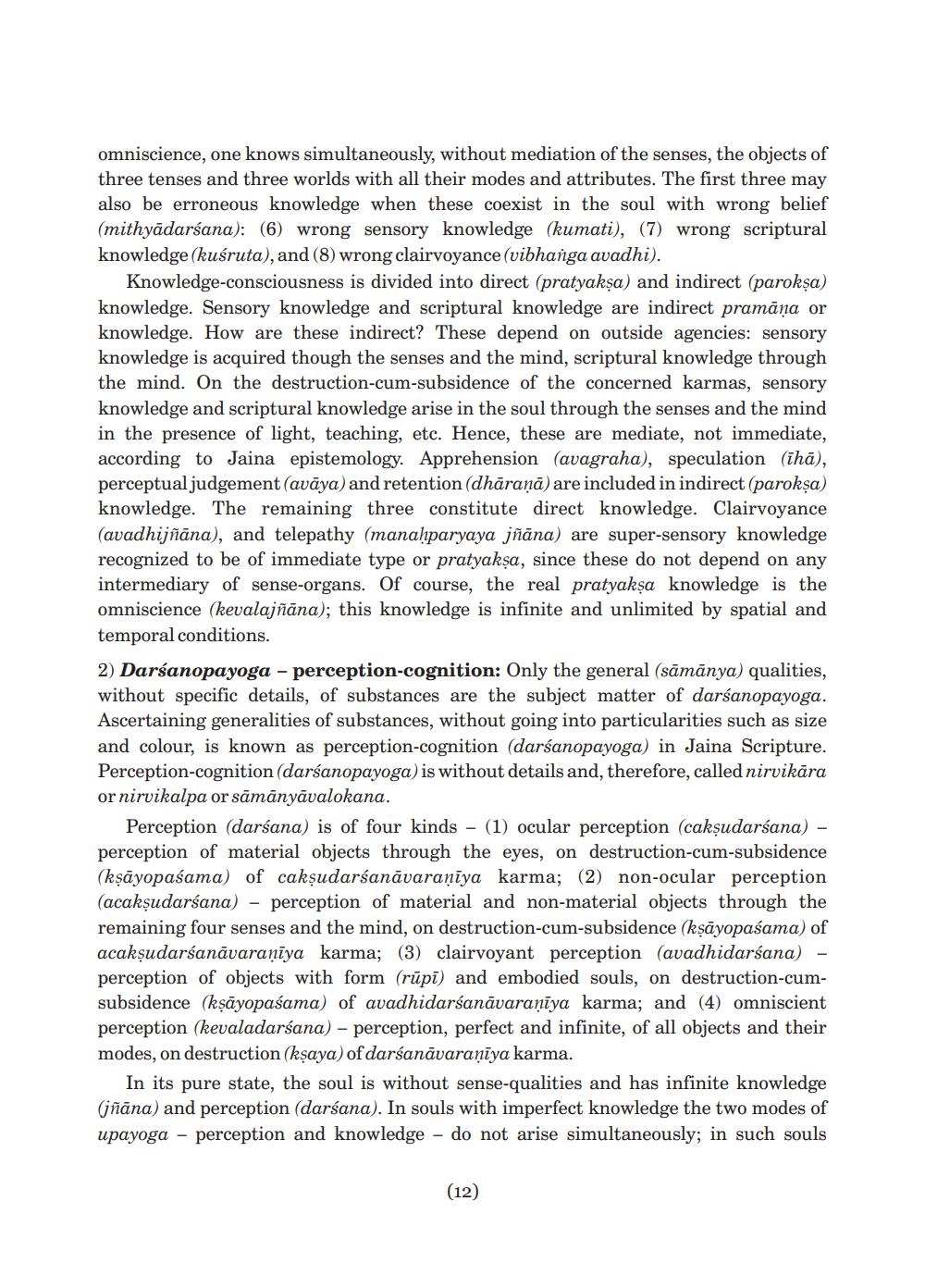________________
omniscience, one knows simultaneously, without mediation of the senses, the objects of three tenses and three worlds with all their modes and attributes. The first three may also be erroneous knowledge when these coexist in the soul with wrong belief (mithyādarśana): (6) wrong sensory knowledge (kumati), (7) wrong scriptural knowledge (kuśruta), and (8) wrong clairvoyance (vibhanga avadhi).
Knowledge-consciousness is divided into direct (pratyakşa) and indirect (parokşa) knowledge. Sensory knowledge and scriptural knowledge are indirect pramāna or knowledge. How are these indirect? These depend on outside agencies: sensory knowledge is acquired though the senses and the mind, scriptural knowledge through the mind. On the destruction-cum-subsidence of the concerned karmas, sensory knowledge and scriptural knowledge arise in the soul through the senses and the mind in the presence of light, teaching, etc. Hence, these are mediate, not immediate, according to Jaina epistemology. Apprehension (avagraha), speculation (ihā), perceptual judgement (avāya) and retention (dhāraņā) are included in indirect (paroksa) knowledge. The remaining three constitute direct knowledge. Clairvoyance (avadhijñāna), and telepathy (manahparyaya jñāna) are super-sensory knowledge recognized to be of immediate type or pratyakşa, since these do not depend on any intermediary of sense-organs. Of course, the real pratyaksa knowledge is the omniscience (kevalajñāna); this knowledge is infinite and unlimited by spatial and temporal conditions. 2) Darśanopayoga - perception-cognition: Only the general (sāmānya) qualities, without specific details, of substances are the subject matter of darśanopayoga. Ascertaining generalities of substances, without going into particularities such as size and colour, is known as perception-cognition (darśanopayoga) in Jaina Scripture. Perception-cognition (darśanopayoga) is without details and, therefore, called nirvikāra or nirvikalpa or sāmānyāvalokana.
Perception (darśana) is of four kinds - (1) ocular perception (cakṣudarśana) - perception of material objects through the eyes, on destruction-cum-subsidence (kṣāyopaśama) of cakşudarśanīvaranīya karma; (2) non-ocular perception (acakşudarśana) - perception of material and non-material objects through the remaining four senses and the mind, on destruction-cum-subsidence (ksāyopaśama) of acaksudarśanāvaranīya karma; (3) clairvoyant perception (avadhidarśana) - perception of objects with form (rūpī) and embodied souls, on destruction-cumsubsidence (kṣāyopaśama) of avadhidarśanavaranīya karma; and (4) omniscient perception (kevaladarśana) - perception, perfect and infinite, of all objects and their modes, on destruction (kşaya) of darśanāvaranīya karma.
In its pure state, the soul is without sense-qualities and has infinite knowledge (ñāna) and perception (darśana). In souls with imperfect knowledge the two modes of upayoga – perception and knowledge - do not arise simultaneously; in such souls
(12)




